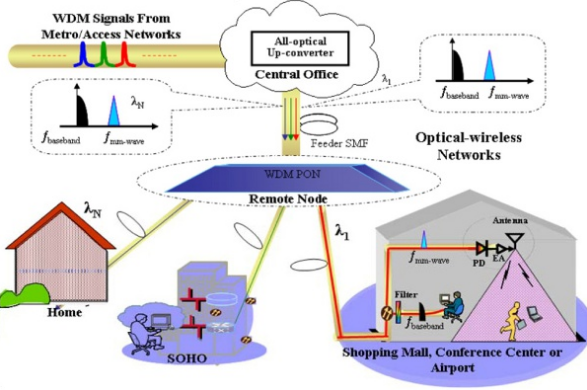- Related articles
- Optical Transceivers for Cisco SLM2048PT-EU Switch
- All Cisco QSFP-4X10G-LR-S's information (Overview, List price, Specs, Datasheet PDF, Compa
- All Cisco SFP-OC12-LR2's information (List price, Specs, Datasheet PDF, Compatibility matr
- Optical Transceivers for Cisco WS-C2960+48TC-L-RF Switch
- All Cisco DS-SFP-GE-T's information (List price, Specs, Datasheet PDF, Compatibility matri
- What Is Network Card PCI Express x8?
- Optical Transceivers for Cisco SG350-28-K9-UK Switch
- Optical Transceivers for Cisco N2K-C2224TP Switch
- All Cisco ONS-GC-GE-LX's information (List price, Specs, Datasheet PDF, Compatibility matr
- What is PCI Express card?

Wireless Optic Networks is referred as the type of data communication network that uses optical fiber technology. This type of communication network uses the optical cables as the primary communication channel for converting as well as passing data as light pulses between receiver and sender nodes. In this case, unguided visible ultraviolet (UV), or infrared light are most used to convert and pass the data from one point to another. Wireless Optical Networks does not use electrical conductors just like other forms of data transmission and therefore, the name wireless comes in. Today, Wireless Optical Networks is widely used around the world especially in developed countries.

How does wireless Optical Networks work?
Required information or data transmitted where the transmitters are of optical transmitters and then they are modulated for the signal transmission which is fed to wireless medium and then led for the transmission. Detector part consists of the optical receivers which are then converted and the transmitted data is obtained.

Uses
Wireless Optical Networks has numerous uses, especially in developed countries. However, the developing countries are gradually adopting the technology. Some of the uses include;
1. Chip-to-chip communications in stacked and closely packed multi-chip packages.
2. Wireless body area network (WBAN) and wireless personal area network (WPAN) applications under standard IEEE 802.15.7, underwater communications.
3. Indoor IR and visible light communications (VLC) for wireless local area networks (WLANs) and inter-vehicular and vehicle-to-infrastructure communications.
4. Inter-building connections also called Free-Space Optical Communications (FSO).
5. inter-satellite links.
The current trend of Wireless Optical Networks
Over the decades, the interest in OWC remained mainly limited to covert military applications and space applications including inter-satellite and deep-space links. OWC’s mass market penetration has been so far limited with the exception of IrDA which became a highly successful wireless short-range transmission solution.[9] Development of novel and efficient wireless technologies for a range of transmission links is essential for building future heterogeneous communication networks to support a wide range of service types with various traffic patterns and to meet the ever-increasing demands for higher data rates. Variations of OWC can be potentially employed in a diverse range of communication applications ranging from optical interconnects within integrated circuits through outdoor inter-building links to satellite communications.
Conclusion
The use of optical networks in the current generation has drastically improved the inter-satellite links globally. In fact, it is very easy to facilitate communication worldwide through the use of satellite links. Consequently, the investigation and security had been improved through the effective communication. Indeed, the wireless optical networks have changed the level of communication globally.





































































